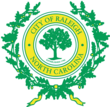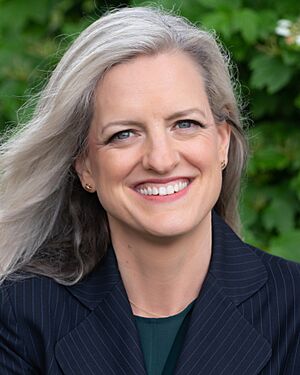Mayor of Raleigh, North Carolina facts for kids
The mayor of Raleigh is the main leader of Raleigh. Raleigh is the capital city of North Carolina in the United States. The mayor works with the Raleigh City Council to help run the city. In Raleigh, the mayor is elected separately from the City Council members. The mayor is the eighth member of the Council.
Quick facts for kids Mayor of Raleigh, North Carolina |
|
|---|---|

Flag of Raleigh, North Carolina
|
|

Seal of Raleigh, North Carolina
|
|
| Member of | Raleigh City Council |
| Seat | Raleigh Municipal Building, Raleigh, North Carolina |
| Term length | Two years |
| Constituting instrument | Act for the Regulation of the City of Raleigh |
| Precursor | Intendant of Police of Raleigh, North Carolina |
| Formation | March 2, 1795 |
| First holder | John Haywood |
How Raleigh's Mayor Role Began
In 1795, the government of North Carolina created a new job. It was called the Intendant of Police of Raleigh, North Carolina. The very first person to hold this job was John Haywood.
At first, a group called the Raleigh Board of Commissioners chose the intendant. These commissioners were picked by the state government. Later, starting in 1803, people living in Raleigh could vote for the intendant. Anyone who owned land in the city could vote. This included free African-Americans. The title "Mayor" was not used until 1856.
Who is Raleigh's Mayor Today?
The current mayor of Raleigh is Janet Cowell. She is a member of the Democratic Party. Before becoming mayor, she was the state treasurer for North Carolina. She was first elected mayor in 2024.
Some mayors have served for a long time. Avery C. Upchurch was mayor for ten years, from 1983 to 1993. Charles Meeker also served for ten years, from 2001 to 2011. Four other mayors have served for eight years each.
How Mayors are Elected
Mayoral elections in Raleigh happen every two years. First, there is a special election in October. This is called a primary election. In this election, candidates do not officially show their political party on the ballot.
If one candidate gets more than half of all the votes, they win right away. If no one gets more than 50% of the votes, the top two candidates move on. They then have a second election in November. This is called a run-off election.
For example, in 2009, Charles Meeker won with 62% of the votes. This meant a run-off election was not needed that year.


